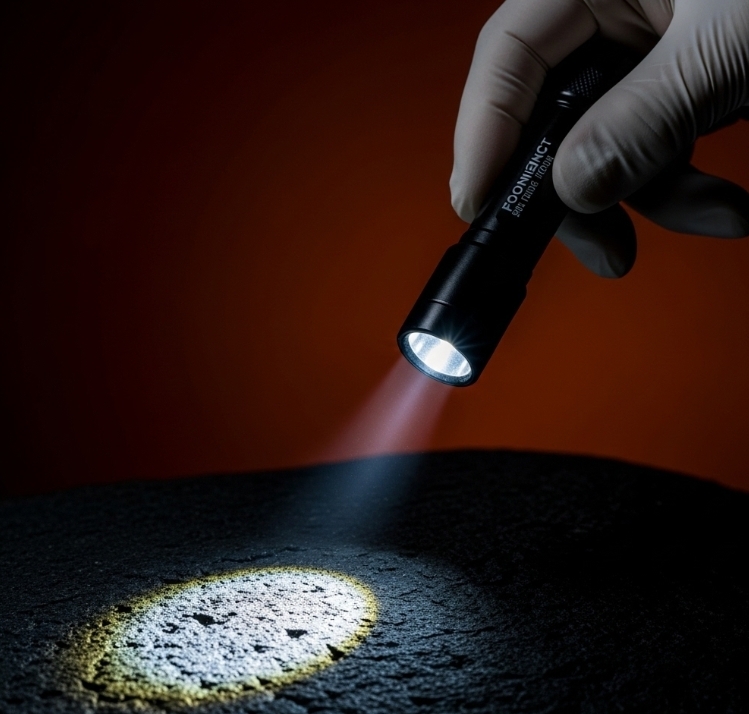UV Flashlight for Forensics: How Investigators Use Ultraviolet Light in Crime Scenes
Posted by Raymond on 11th Aug 2025
UV Flashlight for Forensics: A Crucial Tool for Crime Scene Investigators
In the world of crime scene investigation (CSI), forensic experts rely heavily on UV (ultraviolet) flashlights to uncover evidence invisible to the naked eye. From detecting bodily fluids to enhancing latent fingerprints, UV light is essential in modern forensic science.
This article will explain how UV flashlights work in forensics, what to consider when choosing one, and how they compare to other detection methods.

Why UV Flashlights Are Essential in Forensics
UV flashlights emit ultraviolet light, typically in the 365–395nm wavelength range. This light causes certain substances to fluoresce, making them visible in dark or low-light conditions. Here's what forensic investigators can detect:
| Evidence Type | How UV Light Helps |
|---|---|
| Blood (sometimes with reagents) | Some components fluoresce under UV with special chemicals |
| Urine, saliva, semen | Fluoresce naturally under UV light |
| Fingerprints (with powders) | UV helps develop and visualize latent prints |
| Fibers and hair | Some fabrics and hair types glow under UV |
| Document alterations | UV can reveal erased or changed ink patterns |
| Drugs and powders | Many illicit substances fluoresce under UV |
Features to Look for in a Forensic UV Flashlight
Choosing a flashlight for forensic use isn’t like buying a regular one. Here are the key features that matter most:
| Feature | Why It’s Important in Forensics |
|---|---|
| Wavelength (365nm–395nm) | Determines visibility of biological materials |
| Beam Uniformity | Ensures consistent lighting for accurate evidence visualization |
| Battery Life | Long usage required for crime scene analysis |
| Filter Integration | Helps isolate fluorescence without background glare |
| Portability & Size | Compact and lightweight for fieldwork |
| Durability (IP rating) | Needed for outdoor or contaminated environments |
Best UV Flashlights for Forensic Investigations (2025 Picks)
| Flashlight Model | Wavelength | Special Features | Ideal For | Price Range |
|---|---|---|---|---|
| Tank007 UV302 | 365nm | Filtered lens, waterproof | CSI, labs, professional use | $60–$80 |
| Convoy S2+ UV | 365nm | Nichia LED, filtered optics | Field investigations | $40–$55 |
| Nitecore CU6 | 365nm + white | Dual-mode for general & UV tasks | Multi-scene applications | $100–$120 |
| Streamlight Twin-Task | 390nm | Affordable, dual beam | Entry-level investigations | $40–$50 |
See how forensic scientists use UV light in biological and trace evidence detection.
UV Flashlight vs. Alternative Methods in Forensics
| Detection Method | UV Flashlight | Alternative Tools (e.g., Luminol, ALS) |
|---|---|---|
| Cost | Affordable (from $40) | Often expensive |
| Ease of Use | Simple, handheld | May require lab setup or training |
| Safety | Generally safe with precautions | Some chemical reagents are hazardous |
| Portability | Highly portable | ALS tools can be bulky |
| Sensitivity | Good for many stains, not blood alone | Luminol more sensitive to blood |
Safety Tips When Using UV Flashlights in Forensics
-
Always wear UV-protective glasses to protect your eyes from prolonged exposure.
-
Avoid direct skin exposure, especially with high-powered flashlights.
-
Use in a controlled environment to ensure visibility and accurate detection.
-
Store devices properly to avoid damage or battery leakage.
Final Thoughts
UV flashlights have revolutionized crime scene analysis, offering a fast, portable, and affordable way to uncover hidden evidence. When paired with other forensic techniques, they help professionals build stronger cases and reveal truths that might otherwise go unnoticed.
? Explore professional-grade Tank007 forensic UV flashlights for precision detection in real-world investigations.
